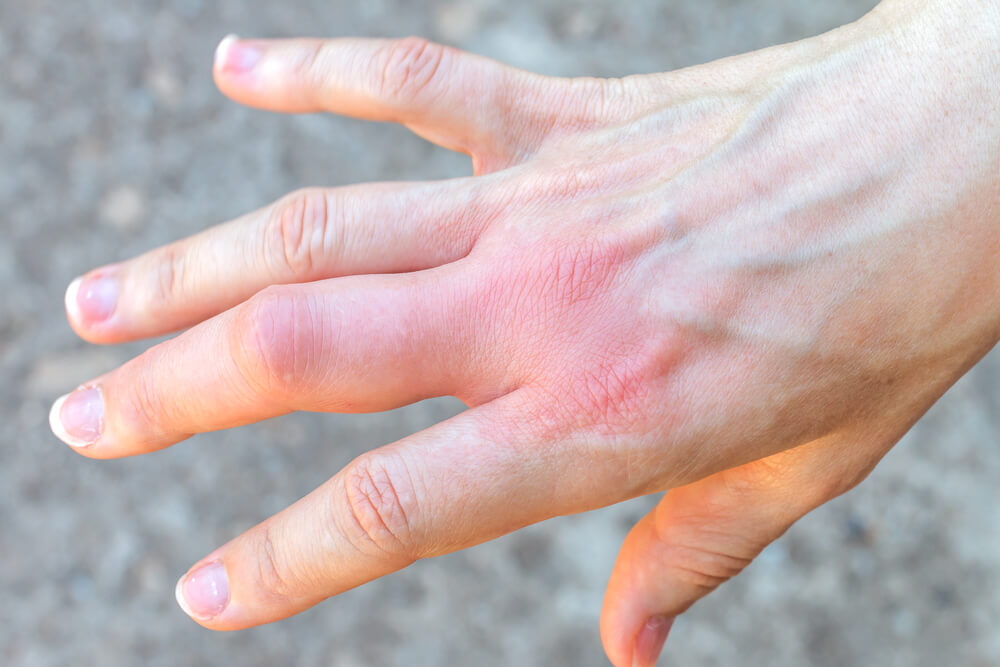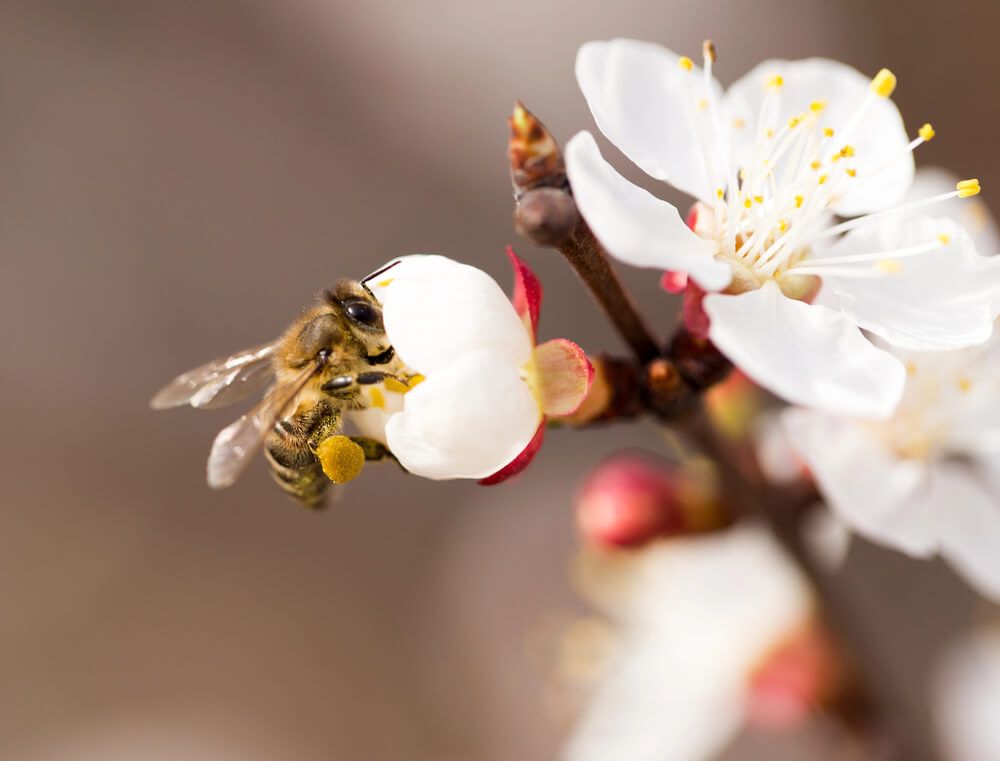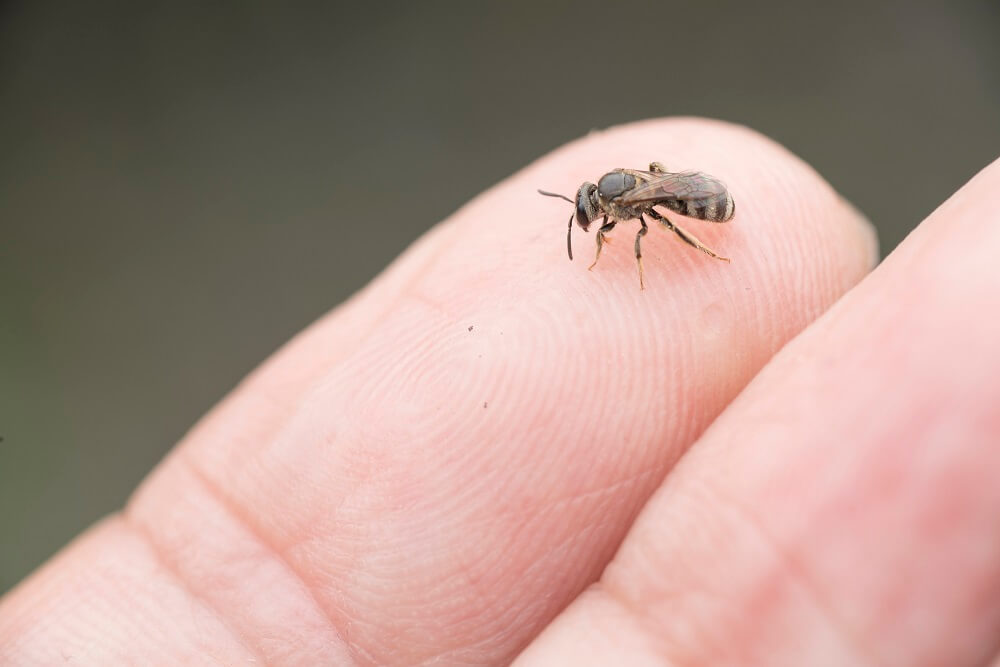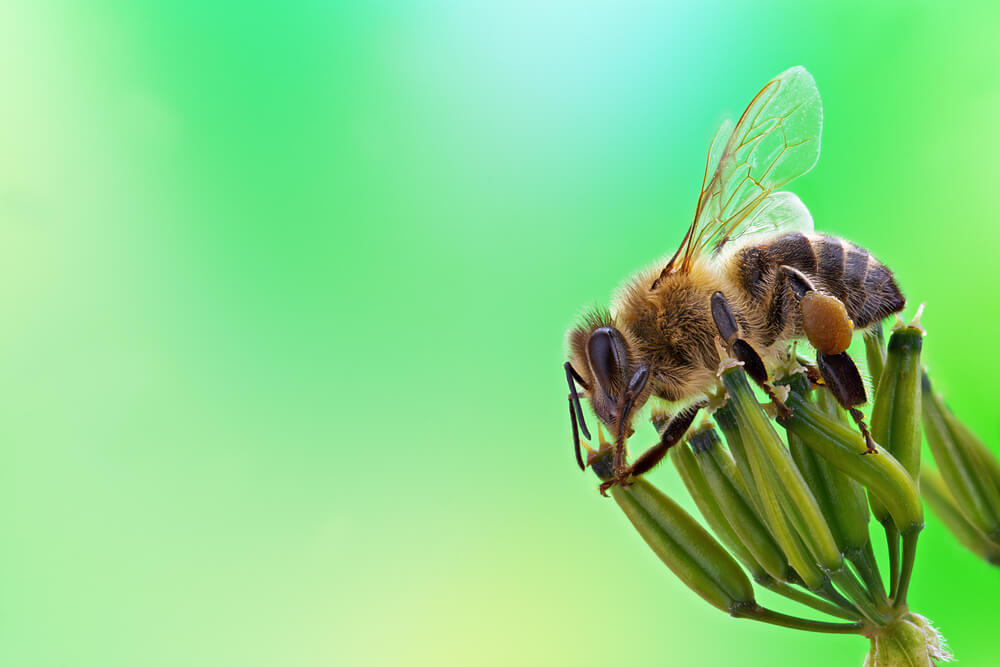Table of Contents:
What Do I Put on a Bee Sting?
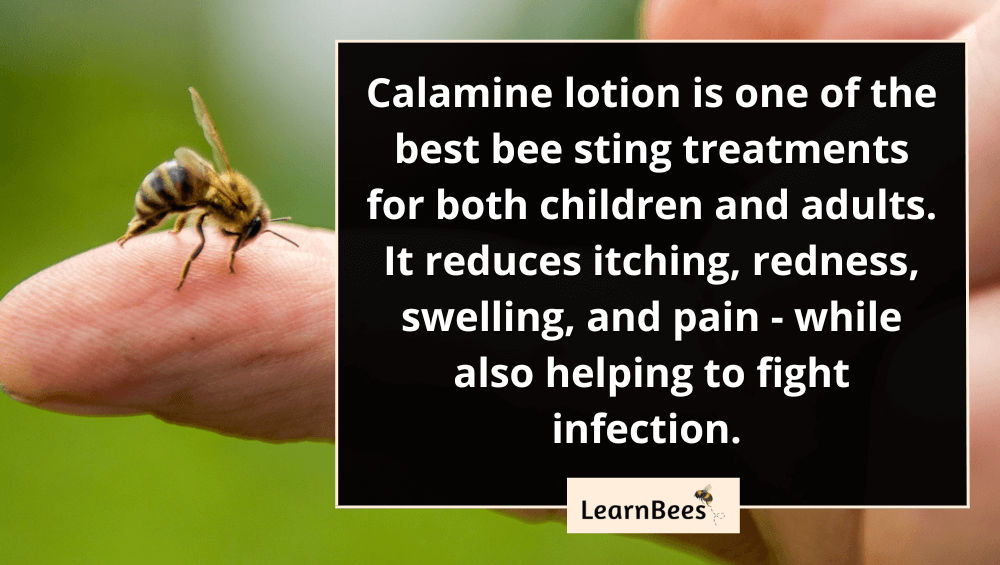
The best thing to put in a bee sting is calamine lotion. Calamine lotion is a powerhouse cream because it reduces itching, swelling, and pain – while also helping to prevent infections.(1, 2)
Additionally:
Calamine lotion is safe to use for both children and adults.(3)
It “helps with the itching and irritation of bites,” says Dr. Gary Goldenberg, assistant clinical professor of dermatology at Mount Sinai. “Reapply as needed, minimizing scratching as much as possible.”(4)
More importantly?
Calamine lotion is good to keep in the medicine cabinet because it can treat other things, such as bug bites, shingles, chickenpox, poison ivy, and hives.(5)
But keep in mind:
Before applying the calamine lotion for a bee sting, remove the stinger first (if applicable) and cleanse the area with soap and water.
From there, you can apply the lotion and wrap the area in a bandage. Pain, itching, and swelling should subside within four to six hours for most.
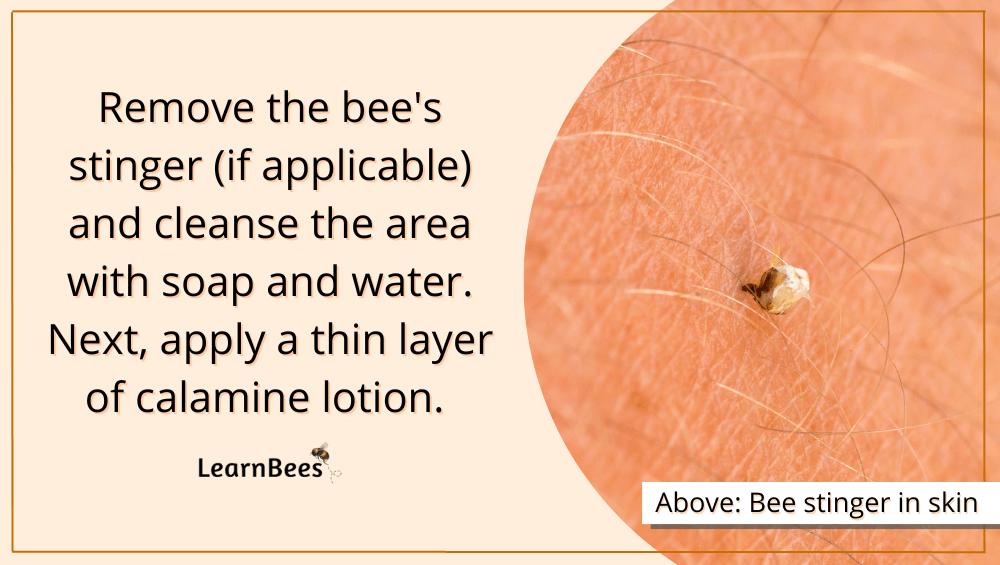
Now here’s the thing:
Not all bees leave their stingers behind.
In fact, honeybees are the only type of bee that lose their stinger. Other bee species, such as bumblebees and carpenter bees, can sting without losing their stinger. Additionally, wasps also keep their stingers.
Honeybees lose their stingers because they’re barbed with small “hooks” in them. The hooks get stuck inside our skin, causing the honeybee’s stinger to get left behind once it flies away.
In contrast?
Wasps and other bee species have smooth stingers that don’t get lodged inside our skin.
With that said, honeybees are some of the most common bees found in the United States. So it’s not uncommon for a bee sting to come from a honeybee.
In the case of a honeybee sting, you should remove the stinger immediately to reduce the amount of venom absorbed into your skin. Honeybee stingers are attached to a venom sac which pumps venom into your skin.(6)
The faster you remove it, the less venom gets absorbed.
What are Common Home Remedies for Bee Stings?
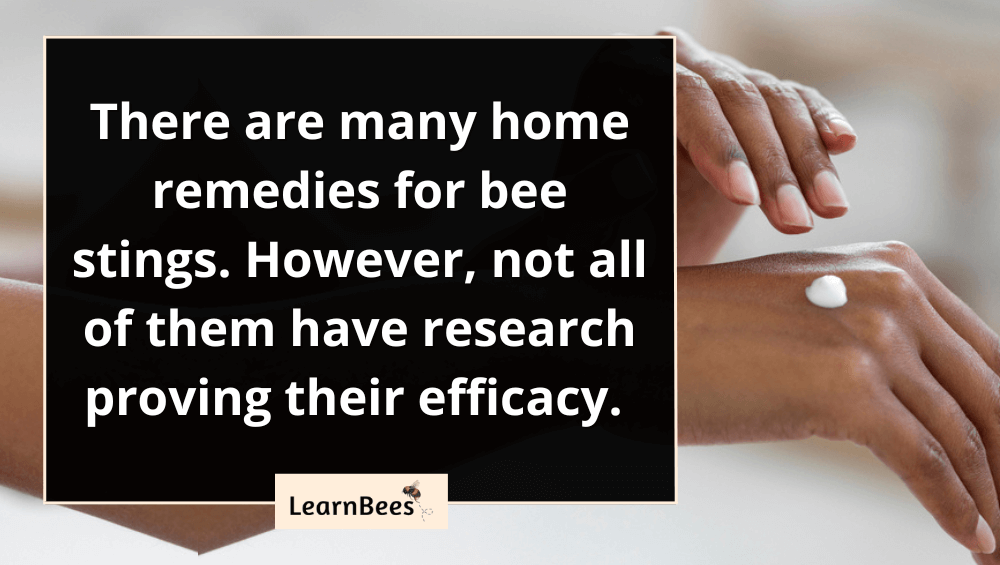
In addition to calamine lotion, there are a few other common home remedies for bee stings. Some have research showing their efficacy, while others have anecdotal evidence.
You can try them to see if they work for you. However, stop and consult a doctor if irritation occurs.
Common bee sting home remedies include:
- Ice: Rest an ice pack on the area for ten to twenty minutes at a time. This helps to reduce pain and swelling.
- Honey: Raw honey has antibacterial and anti-inflammatory properties that can help to soothe a bee sting. Apply a small amount of raw honey to the area and leave it on overnight.
- Baking soda: Mix one teaspoon of baking soda with water to form a paste and apply it to the affected area. Leave it on for fifteen minutes before washing it off with cool water.
- Apple Cider Vinegar: Saturate a cotton ball in vinegar and rub over the bee sting. Leave it on for fifteen minutes before washing it off with cool water.
- Lemon juice: Like vinegar, soak a cotton ball in lemon juice and apply it to the bee sting. Leave it on for fifteen minutes before rinsing it off with cool water. Stop using the juice if irritation occurs.
- Essential oils: Some essential oils, such as lavender oil, tea tree oil, and peppermint oil, have anti-inflammatory and pain-relieving properties. Add a few drops of oil to a cotton ball and apply it to the bee sting.
- Aloe vera: Aloe vera has soothing properties that can help to reduce pain and inflammation. Apply a small amount of gel to the affected area and leave it on overnight, covering it with a bandage.
- Witch hazel: Witch hazel is an astringent that can help to reduce swelling and pain. Apply it to the bee sting with a cotton ball and leave it on overnight for best results. Reapply as needed.
- Toothpaste: The menthol in toothpaste can help numb a bee sting’s pain. Apply a small amount of toothpaste to the affected area and leave it on for fifteen minutes before rinsing it with cool water.
- Crushed aspirin paste: Crush an aspirin tablet and mix it with a small amount of water to form a paste. Apply it to the bee sting and leave it on for fifteen minutes before rinsing it off with cool water.
How Long Does a Bee Sting Last?
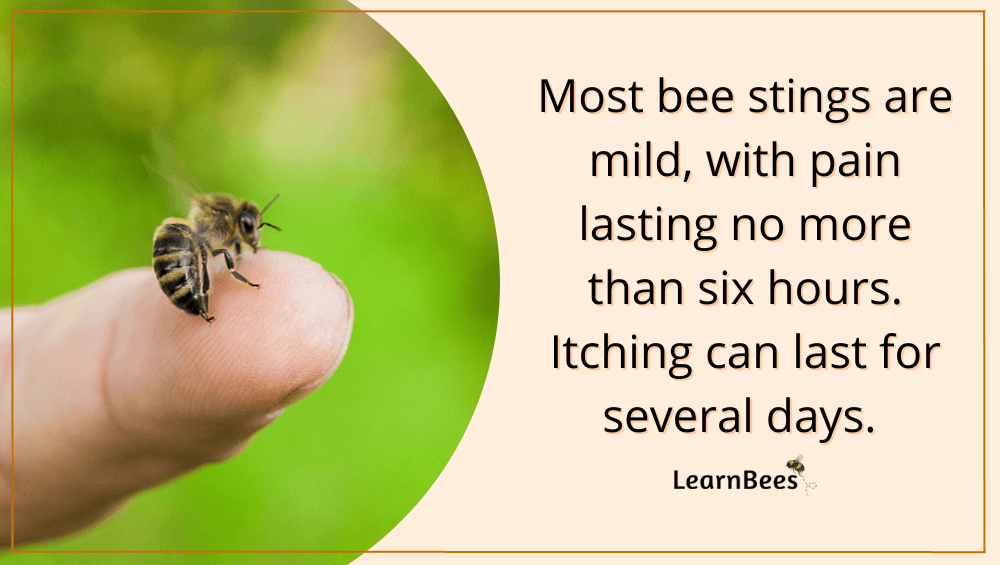
Most adults and children experience discomfort for up to four to six hours after the stinging occurs. Itching for several days is entirely normal.(7)
After that, the pain will subside, and the redness and swelling will gradually decrease over the next few hours or days.
This is known as a mild reaction.
Moderate reactions typically take longer to recover from. Pain can last anywhere from 24-48 hours, while redness, swelling, and itch can last up to seven days. Moderate bee sting reactions are less common, only happening in a small number of people.
Severe bee sting reactions are extremely rare but can signify anaphylaxis. Anaphylaxis is a sudden, potentially life-threatening allergic reaction.(8)
Severe reactions occur in less than three percent of the population.(9)
Symptoms of a severe bee sting reaction include:
- Difficulty breathing
- Swelling of the face, throat, or tongue
- Hives
- Nausea or vomiting
- Dizziness
If you experience any of these symptoms after a bee sting, seek emergency medical attention immediately.
FAQs on What to Put in a Bee Sting
- What stops the pain of a bee sting?
- How do you treat a bee sting at home?
- What’s the best bee sting swelling treatment?
- What do I put on a child’s bee sting?
- Does toothpaste help bee stings?
- Should you put ice on a bee sting?
- Is vinegar good for a bee sting?
- How long does a bee sting last for?
- What happens if a bee sting is left untreated?
- How do you draw out a bee stinger?
- Is heat or cold better for bee stings?
- Can a bee sting be fatal?
- Does baking soda help bee stings?
- Does crushed aspirin help bee stings?
- Does hydrogen peroxide help with bee stings?
What stops the pain of a bee sting?
The best treatment for a bee sting is cleaning the area with soap and water, then applying calamine lotion. Calamine lotion will help to soothe the pain and itchiness. If the pain is severe, you can take ibuprofen or acetaminophen.
—> Go back to the FAQs on what to put in a bee sting
More to Explore:
- How to Remove a Bee Stinger Stuck Under Skin
- 15 Fun Facts About Bees
- 8 Popular Flowers for a Bee Garden
How do you treat a bee sting at home? What’s the best home remedy for bee stings?
Bee stings can be treated at home using calamine lotion or hydrocortisone cream. There are also popular home remedies for bee stings. However, not all of them have research to back up their efficacy.
That said, some home remedies include:
- Baking soda
- Honey
- Toothpaste
- Vinegar
- Lemon juice
- Aloe vera
- Witch hazel
- Crushed aspirin paste
—> Go back to the FAQs on what to put in a bee sting
More to Explore:
What’s the best bee sting swelling treatment?
The best way to reduce swelling from a bee sting is to apply ice to the area for fifteen minutes, then remove it for fifteen minutes. Repeat this process for one hour. You can also take antihistamines to help with swelling.
From there, apply a thin layer of calamine lotion to the area. If the swelling is severe, see a doctor for additional treatment.
—> Go back to the FAQs on what to put in a bee sting
More to Explore:
What do I put on a child’s bee sting?
If your child has been stung by a bee, the best thing you can do is to remain calm. Give them a children’s acetaminophen or ibuprofen if they are in pain. Clean the area with soap and water, then apply a thin layer of calamine lotion or hydrocortisone cream.
If your child reacts to pain and swelling (difficulty breathing, hives, etc.), seek emergency medical attention immediately.
—> Go back to the FAQs on what to put in a bee sting
More to Explore:
Does toothpaste help bee stings?
No scientific evidence supports the claim that toothpaste helps bee stings. However, some believe it can help to soothe the pain and itchiness.
—> Go back to the FAQs on what to put in a bee sting
More to Explore:
Should you put ice on a bee sting?
Yes, you can put ice on a bee sting to reduce swelling. Apply the ice for fifteen minutes, then remove it for fifteen minutes. Repeat this process for one hour.
—> Go back to the FAQs on what to put in a bee sting
More to Explore:
Is vinegar good for a bee sting?
No scientific evidence supports the claim that vinegar is good for bee stings. However, some believe it can help to soothe the pain and itchiness.
—> Go back to the FAQs on what to put in a bee sting
More to Explore:
How long does a bee sting last for?
A bee sting’s pain and swelling will typically last four to six hours. If you experience more severe symptoms, you may consider visiting a doctor.
—> Go back to the FAQs on what to put in a bee sting
More to Explore:
- Ground Bees: Are They a Threat to Your Yard?
- Wasps vs. Honeybees: Are They Different?
- Do Bumble Bees Bite?
What happens if a bee sting is left untreated?
A bee sting is not usually dangerous if left untreated.
Most people experience minor reactions that heal within a few days. However, in some cases, a severe allergic reaction can occur, which can be life-threatening. If you experience symptoms beyond pain and swelling (difficulty breathing, hives, etc.), seek emergency medical attention immediately.
—> Go back to the FAQs on what to put in a bee sting
More to Explore:
How do you draw out a bee stinger?
If a bee stinger is still embedded in your skin, you can remove it by gently scraping it away with a credit card or driver’s license. Avoid squeezing the venom sac, as this can release more venom into your system. Once the stinger is removed, wash the area with soap and water.
—> Go back to the FAQs on what to put in a bee sting
More to Explore:
- Do Carpenter Bees Pollinate?
- How Long Do Bumble Bees Live?
- Honeybees vs. Bumblebees: How Do They Compare?
Is heat or cold better for bee stings?
Cold is typically better for bee stings, as it will help to reduce swelling. Apply ice to the area for fifteen minutes, then remove it for fifteen minutes. Repeat this process as needed until swelling decreases. You can also take antihistamines to help with swelling.
—> Go back to the FAQs on what to put in a bee sting
More to Explore:
- Do Queen Bees Eat Honey?
- Are Worker Bees Male or Female?
- Queen Bee Versus Worker Bees – How Do They Compare?
Can a bee sting be fatal?
Bee stings can be fatal in some very rare circumstances. However, severe bee sting reactions occur in less than three percent of individuals. Fatalities occur in even fewer percentages than that. Most people experience minor reactions that heal within a few days.
If you are concerned about the possibility of a fatal reaction, seek emergency medical attention immediately after being stung. Early treatment can be lifesaving for people with anaphylaxis to bee stings.
—> Go back to the FAQs on what to put in a bee sting
More to Explore:
Does baking soda help bee stings?
No scientific evidence supports the claim that baking soda helps bee stings. However, some believe it can help soothe redness, swelling, and itch.
Mix one teaspoon with one to two tablespoons of water to use baking soda. Apply the mixture to the affected area and let it dry. Rinse it off with warm water after fifteen to twenty minutes. Repeat as needed.
—> Go back to the FAQs on what to put in a bee sting
More to Explore:
Does crushed aspirin help bee stings?
No scientific evidence supports the claim that crushed aspirin helps bee stings. However, some believe it can help soothe pain and inflammation.
Mix one or two tablets with water to form a paste to use crushed aspirin. Apply the paste to the affected area and let it dry. Rinse it off with warm water after fifteen to twenty minutes. Repeat as needed.
—> Go back to the FAQs on what to put in a bee sting
More to Explore:
Does hydrogen peroxide help with bee stings?
Yes, hydrogen peroxide can help with bee stings initially because it’s a mild antiseptic. However, it can also sting quite a bit. To use hydrogen peroxide, apply it directly to the affected area with a cotton ball or swab.
After applying it to the skin, there is no need to rinse the hydrogen peroxide. The stinging should stop within a minute or two. If it continues, you can rinse the area with water.
